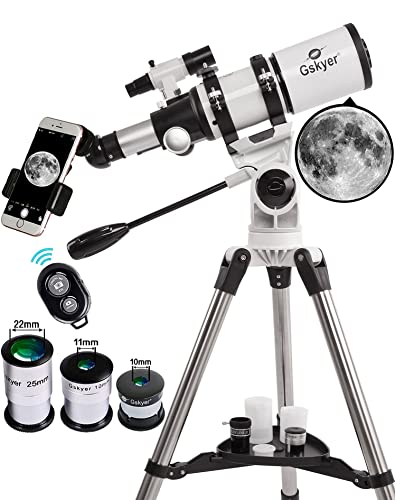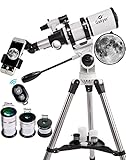Top 10 Telescopes For Beginners
What Is Telescopes For Beginners?
Telescopes for beginners are specially designed to help those new to astronomy get started with observing the night sky. They come in many different shapes, sizes, and styles, but they all have one thing in common: they make it easier for you to view celestial objects like stars, planets, and galaxies. These telescopes typically have a simple design that is easy to use and understand. They often feature basic controls and settings that allow beginners to adjust the focus and magnification of their telescope without getting overwhelmed by complex features. One important aspect of beginner telescopes is their portability. Many models are lightweight and compact enough for you to take them on outdoor adventures or move them around your backyard easily. This makes it possible for you to explore different areas of the sky from various locations. Telescopes for beginners can be an excellent investment if you’re looking to start exploring the wonders of our universe. By choosing a model that suits your needs and preferences, you’ll be able to enjoy countless hours of stargazing while expanding your knowledge about space science.How Does Telescopes For Beginners Work?
Telescopes work by gathering and magnifying light from distant objects in space. They have a series of lenses or mirrors that help to focus the incoming light into an image that can be seen by the observer. The objective lens or mirror is responsible for capturing as much light as possible. This is important, especially when observing faint objects like galaxies or nebulae. Once the light has been captured, it passes through a series of lenses and mirrors within the telescope’s tube. These components help to correct any distortions caused by the Earth’s atmosphere and ultimately produce a clear image of what you’re looking at. Telescopes also come with eyepieces which determine how magnified your view will be. Beginner telescopes tend to have relatively simple designs, making them easier to use than more advanced models. However, they may not provide as sharp an image quality due to their smaller size and fewer features compared to professional-grade equipment. Understanding how telescopes work helps beginners appreciate just how incredible these devices are for viewing our universe.The Different Types of Telescopes For Beginners
There are three main types of telescopes for beginners: refractor, reflector, and compound. Refractors use lenses to focus light and are great for viewing planets, stars, and the moon. They tend to be more expensive but require little maintenance. Reflectors use mirrors instead of lenses and are better suited for deep-sky observations as they collect more light. However, they can be bulkier and require regular maintenance. Compound telescopes combine both lenses and mirrors in their design resulting in a compact yet powerful telescope that is good for both celestial objects and terrestrial viewing. However, they can come with a high price tag. Another type of telescope that is gaining popularity among beginners is the Dobsonian telescope which is a type of reflector telescope mounted on a simple wooden base making it easy to operate without any complicated setup procedures or gadgets. Ultimately, the choice between the different types of telescopes will depend on personal preferences such as budget constraints, observing goals or even portability requirements when considering whether you’re going to observe from home or take your scope with you during camping trips or star parties.Factors to Consider Before Buying Telescopes For Beginners
When it comes to buying a telescope for beginners, there are a few factors that you should consider before making your purchase. These will help ensure that you choose the right telescope for your needs and don’t end up wasting money on something that won’t work well for you. Firstly, think about what type of observing you want to do. Do you want to focus on planets or deep-sky objects? Different types of telescopes are better suited for different types of viewing. Secondly, consider the aperture size. This is the diameter of the main lens or mirror and can greatly affect how much light is gathered and how bright images appear. Thirdly, think about portability and ease of use. Will you need a telescope that can be easily transported or set up quickly? Don’t forget about your budget. Telescopes can range in price from a couple hundred dollars to several thousand dollars depending on their features and capabilities. By taking these factors into consideration before buying a telescope for beginners, you’ll be able to make an informed decision and get the most out of your new hobby!Benefits of Using Telescopes For Beginners
Using telescopes for beginners can be a fun and rewarding experience. Whether you’re interested in stargazing, exploring the universe or simply observing wildlife from afar, there are many benefits to owning a telescope. One of the primary benefits is improving your knowledge about astronomy. You’ll learn about planets, stars and constellations that you may have never seen before. This newfound knowledge can also lead to a greater appreciation of our place in the universe. Telescopes for beginners also provide an opportunity to spend time outdoors and enjoy nature. Observing wildlife such as birds or deer from afar can be an exciting way to connect with nature and get some fresh air. Another benefit of using telescopes for beginners is that they can help improve your patience and focus. Setting up a telescope requires careful attention to detail, while observing objects through it requires patience as well as concentration. Using telescopes for beginners offers a unique opportunity for quality time with friends or family members. Sharing experiences under the night sky together creates unforgettable memories and fosters meaningful connections between loved ones. Owning a telescope has numerous benefits beyond just being able to see farther into space – including improving your knowledge, connecting with nature, developing patience & focus skills as well as creating special moments with others around you!The Pros and Cons of Telescopes For Beginners
Telescopes for beginners can provide an excellent introduction to the world of stargazing. However, like any other product on the market, they also have their advantages and disadvantages. Pros: One of the biggest pros of telescopes for beginners is that they are generally easy to use. They often come with simple instructions that make setup a breeze. Additionally, many beginner telescopes are relatively affordable compared to more advanced models. Another advantage is that novice astronomers can begin exploring the universe right away. Many entry-level telescopes come with accessories such as eyepieces, tripods, and software guides that help users get started quickly. Cons: A major drawback of beginner telescopes is their limited power and capabilities. While you can still see some amazing objects in space at this level, these scopes won’t be able to spot some fainter celestial bodies or provide detailed views. Additionally, some cheaper models may not be as durable or well-constructed as higher-end options. This means they may require more maintenance over time and could break down sooner than expected. Ultimately, while there are both positives and negatives associated with using a telescope for beginners, it’s important to weigh all factors before making a purchase decision.Tips For Setting Up Your Telescopes For Beginners
Setting up a telescope can be intimidating, especially for beginners. Here are some tips to help you get started. Firstly, choose the right location. It’s essential to find a place with minimal light pollution and obstruction from trees or buildings. The ideal spot would have an unobstructed view of the sky. Secondly, assemble your telescope according to its manual instructions. This step-by-step guide will help you avoid any mistakes that could damage your equipment and affect your viewing experience. Thirdly, align your finder scope with the main telescope lens before taking it outside. Aligning these two elements will make it easier for you to locate objects in the night sky accurately. Fourthly, set up your tripod on level ground and ensure that it is stable enough to support the weight of your telescope. Once everything is set up correctly, take time adjusting the focus knob till images appear clear in sight. Practice observing different celestial bodies before attempting astrophotography as this often requires additional equipment and knowledge about advanced astronomy techniques. Remember not every celestial body looks good through a camera so enjoy what looks great through eyepieces!FAQs
FAQs (Frequently Asked Questions) are common when it comes to telescopes for beginners. Here are some of the most frequently asked questions and their answers: What is the best type of telescope for a beginner? The best type of telescope depends on personal preference, budget, and intended use. Refractor telescopes are good for viewing planets and stars, while reflector telescopes are better suited for deep sky objects. How much should I expect to spend on a beginner’s telescope? Beginner telescopes can range from $50 to $500 depending on the type, quality, and features. It is important to consider your budget before purchasing a telescope. Can I use my smartphone with my beginner’s telescope? Yes! Many modern beginner’s telescopes come with phone adapters that allow you to attach your smartphone camera lens or screen to the eyepiece for photography or video recording. Do I need additional accessories with my beginner’s telescope? It really depends on what you want to do with your telescope. Some useful accessories include extra lenses or filters, Barlow lenses which increase magnification power, finderscopes which help locate objects in space more easily. How do I care for and maintain my beginner’s telescope? Cleaning regularly after usage is key – using compressed air blowers or soft-bristled brushes can help remove dust particles without damaging optics. Always store it in dry places free from environmental wear such as humidity. Remember that investing time into research about buying a beginner’s scope will help ensure you get one that suits all your needs at an affordable price point!Conclusion
Choosing the best telescope for beginners doesn’t have to be a daunting task. By understanding the different types of telescopes available and considering factors such as portability, ease of use, and budget, you can make an informed decision that will allow you to explore the wonders of space. Remember to also consider your personal interests and what you hope to achieve with your telescope. Whether it’s observing planets or exploring deep sky objects, there is a beginner-friendly option out there for everyone. We hope this guide has been helpful in narrowing down your options and making your decision easier. Happy stargazing!I’m Ella Andrews, owner of the website https://bestconsumerstips.com/
I give you valuable information about good products to help you choose the best product.











